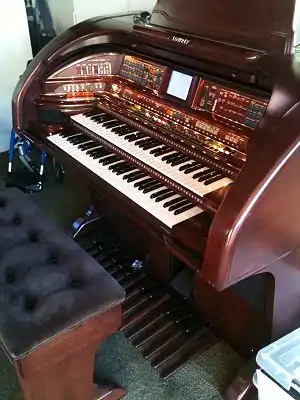List of Hammond organs
The Hammond organ is an electric organ, invented by Laurens Hammond and John M. Hanert[1] and first manufactured in 1935.[2] Various models were produced, which originally used tonewheels to generate sound via additive synthesis, where component waveform ratios are mixed by sliding switches called drawbars and imitate the pipe organ's registers. Around 2 million Hammond organs have been manufactured, and it has been described as one of the most successful organs ever.[3] The organ is commonly used with, and associated with, the Leslie Speaker.

Tonewheel organs
Tonewheel organs generate sound by shaped mechanical wheels, that rotate in front of electromagnetic pickups. Each tonewheel assembly creates tones with low harmonic content, close to a sine wave. Inside the coil is a permanent magnet. As the profile of the tonewheel pass by, the strength of the magnetism changes—when the highest part is closest to the tip of the magnet, the magnetism is strongest. As the magnetism varies, that induces an alternating current (AC) in the coil, which becomes one of the frequencies used in harmonic synthesis.[4]
| Image | Model Name / Number | Years produced | Description |
|---|---|---|---|
| A | 1935–1938[5] | The first Hammond in production. Two 61-note manuals, 25-note pedalboard, 2 x 9 drawbars per manual, 2 pedal drawbars, 9 presets per manual, a tremolo effect generator ("tremulant").[5] | |
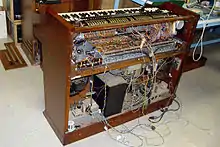 |
A-100 | 1959–1965[6] | A B-3 / C-3's internals in an integrated package with power amp and speakers[7] |
 |
B-A | 1938[8] | Model B-C style organ with built-in player organ mechanism[9] (possibly Duo-Art), custom built by Aeolian-Skinner.[10] |
 |
B-C | 1936–1942[11] | The first organ produced in the deeper Model B cabinet, to accommodate the chorus generator[11] |
 |
B-2 | 1949–1954[12] | Model B style cabinet with variable vibrato (V1, V2, V3, C1, C2, C3) |
 |
B-3 | 1954–1974[13] | The best known Hammond. Similar to the B-2, but with the added harmonic percussion circuit. Made famous by Jimmy Smith who influenced numerous other players.[14] |
_-_brighten.jpg.webp) |
C-2 | 1949–1954[12] | Model C style cabinet with variable vibrato (V1, V2, V3, C1, C2, C3) |
 |
C-3 | 1954–1974[13] | The second best known Hammond. Similar to the C-2, but with the added harmonic percussion circuit |
.jpg.webp) |
D | 1939–1942[8] | A model C organ with factory supplied chorus generator |
| D-100 | 1963–1969[15] | Internals of an RT-3 with built-in amp and speakers | |
 |
E | 1937–1949[16] | The first attempt at a full size American Guild of Organists (AGO) 32-note pedalboard. Also included four toe pistons |
%252C_with_unidentified_electronic_organ_(right)_-_Haus_der_Musik_Stuttgart.jpg.webp) |
E-100 | 1965–1970[17] | A cut-down version of the A-100 |
| E-200 | 1965–1971[18] | A version of the E-100 specifically designed for churches | |
| E-300 | 1965–1969[19] | A version of the E-100 with additional "harp sustain" feature | |
| G-100 | 1964–1967[20] | Non-drawbar tonewheel organ. Included 65 stop tablets, 12 couplers, 18 thumb pistons, 8 toe pistons. Also known as the Grand-100 | |
.jpg.webp) |
H-100 | 1965–1969[21] | Tonewheel organ with extra tonewheels for additional drawbars, higher harmonics. Also had pedal sustain, spring reverb and stereo chorus and vibrato scanners. 50 Watts of three-channel amplification and speakers built in. The quality of the organs has been criticised because of a rushed design and production to try and improve profitability at Hammond.[22] |
| H-200 | 1969–1975[23] | Version of the H-100 designed for churches and theatres | |
| HX-100 | 1970-1975 | Version of the H100 in a pseudo X66 case for stage work. Supplied with D10 speaker. | |
 |
L-100 series | 1961–1968[16] | First Hammond to retail for under £1,000. Much abused by Keith Emerson.[24]
|
.jpg.webp) |
Porta B series |
1971–1974[25] (1970[26]) | Portable version of L-100 series for professional use.[26] There were several versions on each country, built by different factories:
|
_by_Laurens_Hammond_-_Hammond_M_Fig.1.jpg.webp) |
M | 1948–51[12][28] | First spinet organ. 2x44 key manuals, 12 note pedalboard. |
_edit2.jpg.webp) |
M-2 | 1951–1955[12][28] | An M with selectable vibrato |
 |
M-3 | 1955–1964[12][28] | An M-2 with B-3 / C-3 style harmonic percussion |
 |
M-100 | 1961–1968[29] | Tonewheel spinet organ, replacing the M series. Includes presets. |
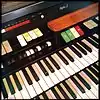 |
R-100 | 1970–1975[30] | E-100 style organ with transistor / solid-state power amp and built-in Leslie |
| RT | 1949 | Replacement for the Model E. Tonewheel organ similar to DV but with 32 note AGO pedalboard | |
| RT-2 | 1949–1954[6] | Like a C-2, but with a full 32 note AGO pedalboard | |
 |
RT-3 | 1954–1969[6] | Like a C-3, but with a full 32 note AGO pedalboard |
.jpg.webp) |
T-100 series | 1968–1975[31] | A tonewheel spinet with a transistor / solid-state power amplifier
|
.jpg.webp) |
X-66 | 1967–1973[32] | 12-tone tonewheel generator with frequency divider and various additional features |
| X-77 | 1968–1973[33] | A restyled H-100, designed to replace the B-3. Had its own Leslie cabinet, the X-77L |
Two models in Church-styled cabinet were made under military specifications, and named G (G for "Government contract", with chorus), and G-2 (with vibrato), to be installed in chapels and officer's messes of U.S. Army and Navy.
Vacuum tube musical instruments
Vacuum tube musical instruments mean electronic musical instruments generating sound with vacuum tube-based electronic oscillators. Hammond Organ Company commercialized it in the late-1930s as Novachord (1939–1942) and Solovox (1940–1948). Especially, new designs introduced on Novachord — subtractive synthesis and frequency divider — were immediately followed by many manufacturers of electronic organs and polyphonic synthesizers during the 1940s-1970s. However, Hammond Organ Company did not adopt these on main products until the late-1960s, except for S series chord organ (1950–1966) and "Solo Pedal Unit" on RT series and D-100 (1949–1969).
| Image | Model Name / Number | Years produced | Description |
|---|---|---|---|
 |
Novachord (model H) | 1939–1942[34] | First commercial polyphonic synthesizer. Although Novachord itself is not referred to as an electronic organ, its basic design became mainstream, being implemented in electronic organs and polyphonic synthesizers during 1940s-1970s. |
 |
Solovox (model J,K,L) |
1940–1950[35] |
Monophonic attachment keyboard instrument, intended to accompany the pianos with lead voice of organ and orchestral sound. It consists of two units — a 3-octave mini keyboard attaching under the piano keyboard, and a tone cabinet including electronic sound generator, amplifier and loudspeaker.[36] The sound generator is based on a vacuum tube oscillator and octave divider circuits originally designed for Novachord. There are three minor changed models:[35]
|
 |
Solo Pedal Unit on RT series and D-100 |
1949–1969[6] |
Solo Pedal Unit (or Pedal Solo Unit) provides a monophonic bright bass sound on RT series and model D-100 consoles, layered with tradiotional polyphonic tonewheel pedal sound. Although Solo Pedal Unit is highest-note priority and it can play only one note at a time, the players can play polyphonic bass lines by the help of traditional pedal sound. The sound generator is electrically similar to Solovox Model L. It consists of a vacuum tube oscillator and five frequency divider circuits, controlled by a volume and 8-stop tablets (Bourdon 32', Bombarde 32', 16', 8', 4', 2' & 1', mute, pedal solo on) placed on the right side of lower manual. Although there are five revisions of units, these are interchangeable on all RT series consoles.[37] |
 |
S series Chord Organ |
1950–1966[38] |
First chord organ. Its "easy to play"[39] style initiated a new market segment leading to today's home keyboard market.[40] The S series Chord Organ can be played via following interfaces:[38]
|
Transistor organs
Hammond started to produce transistor organs when the production of tonewheels became too expensive, switching to full-time Integrated Circuit (IC) models in 1975.[41][42]
| Image | Model Name / Number | Years produced | Description |
|---|---|---|---|
 |
Aurora (Century, Custom and Classic) | 1975[26] | First composite spinet organ with both drawbars and electronic voices, no tonewheels.
Classic top of range with strings brass and presets.Final model had pro-chord. |
| B3000 | 1978[43] (or 1975[44]) | Solid-state copy of the B-3, with additional string division, electric and grand pianos. Key click was re-introduced.[26] Supplied with matching Leslie HL-722. | |
_built_in_Japan.jpg.webp) |
Cadette (model V,VS) |
1969–1970s[45][46] | Entry-level all-tab transistor spinet organ, no tonewheels. This series were all designed in the United States, built in Japan, and subsequently also assembled in England: Initially, first series were built by Yamaha (c.1969–), then by Nihon Hammond during 1973–1975. Subsequently Hammond UK began to import these models in kit form, and assembled in proper wooden cases for domestic market.[45][46] |
 |
Colonnade | 1979[47] or 1982[48] | Console version of Aurora Classic. |
| Monarch | Console organ 1975-? | ||
| Commodore | — | Single set of drawbars. | |
| Elegante | 1980s | Hammond 1980`s Flagship 2 x 61 note manuals,25 pedals everything on it. | |
| Concorde | 1972 - c.1977 (or 1973[26]) | First LSI-based Hammond console organ with drawbars, no tonewheels.[26] This model was once erroneously advertised as a next generation top model take over the X-77, called X-99; though, its official name was the Concorde. | |
| Cougar | 1973–1976[51] | Transistor spinet organ with drawbars, in some extent, corresponded to a kind of successor of L-100 series tonewheel spinet organ, although its new drawbars arrangement is slightly exotic; its upper manual has normal nine drawbars; on the other hand, lower manual has only two 8' drawbars with sawtooth. This anomalous design was only followed by a few models (8000 series, 8100 series, and 8200 Aurora series).[51] | |
| Dolphin | 1973–1976[52] | Spinet organ with built-in polyphonic synthesizer and 20 one finger chords. | |
| J-100 | 1967–1968[53] (Late 1960s[31]) | Transistor spinet organ - no tonewheels | |
 |
Maverick | 1973–1975[54] | Middle-priced all-tab spinet organ. |
 |
Phoenix | 1972[26] | First LSI-based all-tab Hammond spinet organ. |
.jpg.webp) |
Piper Autochord | 1970–1979[55] | First automatic chording instrument. Single manual, with automatic rhythm, automatic chording and no bass pedals.[26] |
| Portable B-100 | 1980–1984[57] | Single manual version of B-250.[57] | |
| Portable B-200 | — | Successor of X-5, portable version of Aurora 8222. | |
| Portable B-250 | 1980–1984[59] | 2 x 61 note manuals.[59] | |
| Portable B-300 | — | B-200 plus strings, portable version of Aurora Classic 232000. | |
| Portable B-400 | — | Only drawbars to upper, drum machine and Midi. | |
 |
Portable X-2 | 1978[26] | Single manual version of X-5. |
 |
Portable X-5 | 1979[12] | Portable spinet, transistor copy of the B-3 (or Porta B), derived from Ace Tone GT-7 circa 1971. Manufactured by Nihon Hammond, a Japanese joint venture between main company and Sakata (parent company of Ace Tone). |
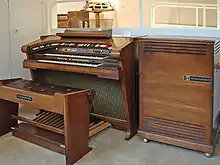 |
Regent | 1973–1976 | First all-tab theatre style Hammond organ. |
 |
Romance series | 1977–1983[65] | Integrated circuit generated spinet organ. No drawbars. |
 |
Sounder | 1973[26] | First Hammond to retail for under $500, sold through both music and mass merchant outlets. Single manual organ. |
Digital organs
After the Hammond Organ Company ceased trading in 1985, production initially went to Noel Crabbe's Hammond Organ Australia, and then to Suzuki Musical Instrument Corporation, who, under the name Hammond-Suzuki, manufacture digital organs.[66]
| Image | Model Name / Number | Years produced | Description |
|---|---|---|---|
| Super B | 1986[48] | First full-digitally sampled Hammond organ, with dual manual, downloadable voice tables, and MIDI.[48] | |
.jpg.webp) |
XB-2 | 1991–1998[12] | Single manual organ. First digital organ produced by Hammond-Suzuki. |
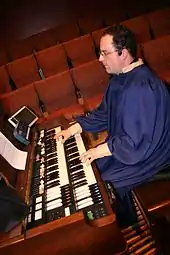 |
XB-3 | 1993–1998[68] | Dual manual organ with 4 sets of drawbars, reverse colour presets and waterfall keys. In an extended B3 case. |
| XB-5 | 1993[68]—? | Two manual organ with two sets of drawbars and bass drawbars.[69] | |
| XM-1 / XM-c1 | 1997–2005[68] | MIDI organ module (XM-1) with drawbar controller (XM-c1) | |
| XB-1 | 1998–2005[68] | Standalone version of the XM-1 | |
| XK-2 | 1999–2004[70] | Improved XB-2 with waterfall keys | |
 |
XE series | — | XE-1 / XE-2 / XE-200: Modular all singing and dancing single manual modular organ (XE-1), dual manual(XE-2), and built in cabinet (XE-200) |
| New B-3 | 2003–present[71] | A replica of the original B-3 with digitally generated tonewheel simulation | |
 |
XK-1 | 2005–2011 | Cut down version of XK-3, but extended vib/cho settings later in XK-3C |
| XM-2 / XM-c2 | 2005–present | MIDI module version of the XK-1 | |
 |
XK-3 | 2004–2007 | Same internals as a New B-3 with cheaper keyboard base and built in Leslie simulator. Can be expanded with optional lower manual, stand and pedalboard.[72] |
 |
XK-3c | 2007–present[73] | Updated version of the XK-3 |
| SK1 | 2011–present[74] | Stage keyboard with pianos and other instrument samples as well as organ | |
| SK-2 | 2011–present | Dual manual SK-1 | |
| XK-1c | 2013–present | Improved XK-1 | |
| XK-5 | 2016–present | 4 drawbar sets + pedal like B3, improved multicontact shallow keybed etc | |
| SK-X | 2018–present | Replaced SK-2 and has 2 sets of drawbars, improved interface and 11-pin Leslie connector |
References
- Bush & Kassel 2006, p. 168.
- Corbin 2006, p. 151.
- Waring 2002, p. 319.
- Reid, Gordon (November 2003). "Synthesizing tonewheel organs". Sound on Sound. Retrieved 25 April 2011.
- Vail 2002, p. 68.
- Vail 2002, p. 74.
- Vail 2002, pp. 74-75.
- Vail 2002, p. 71.
- "Model B-A", The Hammond-Leslie FAQ, VintageHammond.com
- "Aeolian/Hammond Player Organ", Hammond Products, OrganHouse.com. – Two manufacturer plates can be confirmed : one is "Hammond Organ Mechanism Model BA" by Hammond Instrument Co., and the other is "Aeolian-Hammond Player model BA" by Aeolian-Skinner organ Co.
- Vail 2002, p. 69.
- Spark, Rod (October 1997). "The History Of The Hammond". Sound on Sound. Retrieved 30 July 2013.
- Vail 2002, p. 49.
- Vail 2002, p. 19.
- Vail 2002, p. 76.
- Vail 2002, p. 72.
- Vail 2002, p. 77.
- Vail 2002, p. 79.
- Vail 2002, p. 79-80.
- Vail 2002, p. 81.
- Vail 2002, p. 83.
- Vail 2002, p. 85.
- Vail 2002, p. 86.
- Faragher 2011, p. 78.
- BlueBook Hammond and Leslie & c.1984, p. H-9.
- Hammond Zone, Hammond Accomplishments 1970–1979
- Vail 2002, p. 89.
- Vail 2002, p. 91.
- De Hammond Encyclopedia, R 100 serie Retrieved 5 August 2013.
- Faragher 2011, p. 85.
- Vail 2002, p. 93.
- Vail 2002, p. 96.
- Howell, Steve; Wilson, Dan. "Novachord". Hollow Sun. Retrieved 26 April 2011. See also site's History page.
- De Hammond Encyclopedia, Solovox, een extra klavier
- Hammond Zone, The Hammond Solovox (1940).
- Pedal Solo Unit for RT, RT-2, & RT-3 Consoles (PDF). Service Manual. Hammond Organ Company.
- De Hammond Encyclopedia, Hammond S-Series; The Chord Organ
- "New, Easy to Play, Inexhaustible, Exciting ... and Best of All ... Worthwhile ! — Hammond Chord Organ", ad, September 27, 1958
- Hammond Zone, Hammond Accomplishments 1950–1969
- Kakehashi 2002, p. 176.
- Riley 2006, pp. 58,63.
- BlueBook Hammond and Leslie & c.1984, p. H-33.
- Faragher 2011, p. 75.
- De Hammond Encyclopedia, V-100 Cadette series — Serial number plates by Yamaha were printed as: "Built by Nippon Gakki Company, Limited to Specifications of Hammond Organ Company, Chicago, ILL. Made in Japan". Also vivid color tablet buttons and "rice paper finish" wood print panel seem to share the design language of Yamaha Electone at that time.
- De Hammond Encyclopedia, VE & VS series — De HAMMOND VS-serie — Serial number plates (probably not by Yamaha) were simply printed as: "Hammond International, Chicago, ILL. Made in Japan".
- BlueBook Hammond and Leslie & c.1984, p. H-32.
- Hammond Zone, Hammond Accomplishments 1980–1989
- De Hammond Encyclopedia, Cougar 7100 series
- BlueBook Hammond and Leslie & c.1984, pp. H-20–H-22.
- Introductory Section, Service Manual 1970, p. SC-12.
- BlueBook Hammond and Leslie & c.1984, p. H-18.
- BlueBook Hammond and Leslie & c.1984, p. H-14.
- De Hammond Encyclopedia, Hammond B-100 Portable
- De Hammond Encyclopedia, Hammond B-250 Portable
- Welch, Jerry (2011). "Organ Identification". Organ Service Company, Inc. Retrieved 31 July 2013.
- Faragher 2011, p. 14.
- Magnus, Nick (October 1998). "Hammond XB1". Sound on Sound. Archived from the original on 2016-03-03. Retrieved 2 August 2013.
- De Hammond Encyclopedia, Hammond XB-5, "Bovenmanuaal met 61 toetsen - 9 drawbars / Ondermanuaal 61 toetsen - 9 drawbars / Pedaal 25 tonig - 2 drawbars"
- Jacques, David (2001). "Review: Hammond-Suzuki XK-2". none. Archived from the original on 2014-12-27. Retrieved 2 Feb 2014. Cite journal requires
|journal=(help) - Hugh Robjohns. "Hammond B3: Modelled Electromechanical Tonewheel Organ". Sound on Sound (July 2003). Archived from the original on 2006-11-06.
- Robjohns, Hugh (July 2005). "Hammond XK3/XLK3 & Leslie 2121/2101". Sound on Sound. Retrieved 31 July 2013.
- Hart, Terry (12 August 2011). "Hammond XK-3C". Mixdown Magazine. Archived from the original on 22 February 2014. Retrieved 2 August 2013. Cite journal requires
|journal=(help) - Fortner, Stephen (13 December 2011). "Hammond SK1". Keyboard Magazine. Archived from the original on 27 May 2013. Retrieved 2 August 2013.
- Bibliography
- Bush, Douglas Earl; Kassel, Richard (2006). The Organ: An Encyclopedia. Routledge Chapman & Hall. ISBN 978-0-415-94174-7.
- Corbin, Alfred (2006). The Third Element: A Brief History of Electronics. AuthorHouse. ISBN 978-1-4678-1338-9.
- Faragher, Scott (2011). The Hammond Organ : An introduction to the instrument and the players who made it famous. Hal Leonard Corporation. ISBN 978-1-4584-0287-5.
- Kakehashi, Ikutarō (2002). I Believe in Music: Life Experiences and Thoughts on the Future of Electronic Music by the Founder of the Roland Corporation. Hal Leonard Corporation. ISBN 978-0-634-03783-2.
- Riley, Chris (2006). The Modern Organ Guide. Xulon Press. ISBN 978-1-59781-667-0.
- Vail, Mark (2002). The Hammond Organ: Beauty in the B. Backbeat Books. ISBN 978-0-87930-705-9.
- Waring, Dennis G (2002). Manufacturing the Muse: Estey Organs and Consumer Culture in Victorian America. Wesleyan University Press. ISBN 978-0-8195-6508-2.
- Other sources
- "De Hammond Encyclopedia" (in Dutch). Hammond Toonwielorgelvereniging Netherland [Hammond Oragn Club Holland] (hammondclub.nl). Retrieved 2013-08-06.
- Service Manual. Hammond Organ Company.
- Introductory Section (Hammond Organ Models) (PDF). Winterpark, FL: Audio Playground Synthesizer Museum. 2001 [1970]. Archived from the original (retyped PDF) on 2010-11-24. Retrieved 2013-08-07. (recreation of original in 1970); Originally published as: Introductory Section. Service Manual. Melrose Park, Illinois: Hammond Organ Company. 1970. HO-495-1-2500.
- The Blue Book of HAMMOND (PDF). 2001 [c. 1975]. Archived from the original (retyped PDF) on 2016-03-04. Retrieved 2013-08-07.
Note: It seems a retyped copy of original "Introductory Section" of Service Manual in circa 1975, or similar. - BlueBook Hammond and Leslie (scanned image in PDF). 2009 [c. 1984]. Retrieved 2013-08-07.
Note: It seems a reprint of "Introductory Section" of Service Manual circa 1984, or similar.
- "History & Reference". Hammond Zone (hammond-organ.com). Archived from the original on 2018-02-22. Retrieved 2013-08-06.
| Wikimedia Commons has media related to Hammond organs. |
